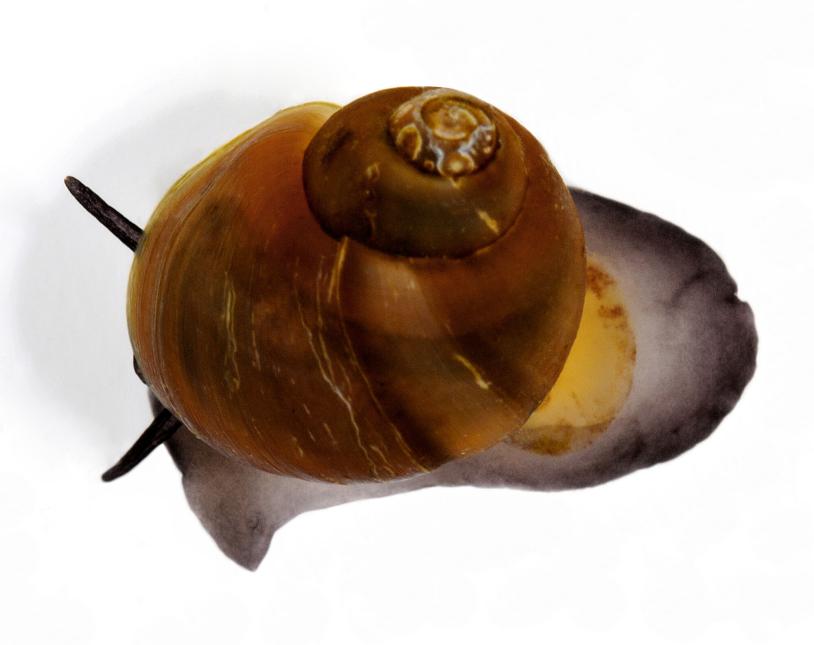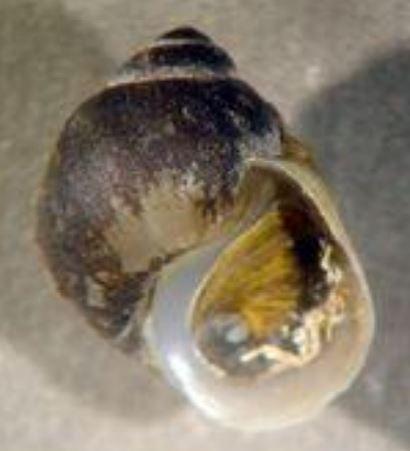The ashy pebblesnail is uncommon in Washington. There are two remaining populations in the Okanogan and Methow Rivers and smaller populations in the Hanford Reach of the Columbia River, with some detections in the Grande Ronde and Methow Rivers. Very few of these occurrences are viable.
Threats to this species include reduced water quality, habitat loss and degradation, and increasing isolation and fragmentation of geographically isolated populations.
Description and Range
Physical description
The ashy pebblesnail is an aquatic snail in the family Lithoglyphidae. The shell measures between ¼ to ½ inches tall, with 4 to 4.5 whorls. They may appear tan, brown or reddish in color.
Ecology and life history
The ashy pebblesnail is inactive in winter. It has no lungs and respires through the mantle cavity, thus requiring a highly-oxygenated atmosphere. It generally occurs in clear, cold streams, under rocks and vegetation in the slow to rapid currents of streams, but is sparse or absent in major rapids. Ashy pebblesnails are restricted to habitat with sufficient flow, oxygenation, and stable substrate.
Species in the genus Fluminicola exhibit separate sexes, with both male and female individuals. Reproduction is by copulation and cross-fertilization, and these species are believed to be semelparous (reproducing only once in a lifetime). Eggs are laid as gelatinous capsules attached to plants, stones, or other objects from spring to autumn.
Fluminicola feed by scraping bacteria, diatoms and other perilithic organisms from rock surfaces, and may occasionally feed on aquatic plant surfaces.
The individual life span is thought to be approximately one to two years. Population turnover is probably greater than 90 percent. Often, species in this genus appear to be community dominants, comprising most of the invertebrate biomass.
Geographic range
The ashy pebblesnail has been extirpated from much of its historical range. It was originally known from the lower Snake and Columbia River drainages in Washington, Oregon, Idaho, British Columbia, and possibly Montana.
In Washington, it was historically widespread, with populations scattered throughout the lower Snake River, lower to middle Columbia River, and large tributaries of these rivers including the Methow, Willamette, Wenatchee, Deschutes, Okanogan, Grande Ronde, and Spokane Rivers. This distribution included Asotin, Benton, Cowlitz, Chelan, Clark, Franklin, Klickitat, Okanogan, Skamania, Spokane, and Walla Walla counties.
For maps of range-wide distribution and conservation status of this species, check out NatureServe Explorer and the International Union for Conservation of Nature’s Red List.
Climate vulnerability
Sensitivity to climate change
Low-
Moderate
There is limited information on the sensitivity of the ashy pebblesnail to climate change.
The ashy pebblesnail’s habitat range is believed to be restricted to the Columbia River Basin’s rivers, streams, and creeks, although its historic range encompassed Washington, Oregon, and Idaho. The ashy pebblesnail requires clear, cold, highly oxygenated streams, and therefore may be sensitive to changes in flow regimes and increases in water temperature that negatively impact dissolved oxygen levels and chemical and biological processes.
Exposure to climate change
Moderate-
High
- Altered flow regimes
- Reduced oxygen
- Increased water temperatures
Conservation
Conservation Threats and Actions Needed
- Fish and wildlife habitat loss or degradation
- Threat: Pollution and siltation.
- Action Needed: Protect water quality.
See the Climate vulnerability section for information about the threats posed by climate change to this species.
Resources
References
Climate Change Sensitivity Database.
Frest, T. J., and E. J. Johannes. 1995. Interior Columbia Basin Mollusk Species of Special Concern. Final Report, Deixis Consultants, Seattle. Prepared for Interior Columbia Basin Ecosystem Management Project, Walla Walla, WA 362 pp.
Hershler, R. and T. J. Frest. 1996. A review of the North American freshwater snail genus Fluminicola (Hydrobiidae). Smithsonian Contributions to Zoology 583: 1-41.
Hershler, R. and H. P. Liu. 2012. Molecular phylogeny of the western North American pebblesnails, genus Fluminicola (Rissooidea: Lithoglyphidae), with description of new species. Journal of Molluscan Studies 78:321-329.
Jordan, S. F. 2013. Ashy Pebblesnail/ Columbia Pebblesnail (Fluminicola fuscus). Species Fact Sheet. Xerces Society. Prepared for the Interagency Special Status/Sensitive Species Program, Forest Service, Bureau of Land Management. 19pp.

